 Written by Heather Collins, MSN, RN, CNOR
Written by Heather Collins, MSN, RN, CNOR
Leg compression machines are primarily used to combat poor circulation and prevent the formation of blood clots. Some conditions that respond well to compression therapy include chronic venous insufficiency, leg ulcers from wounds, and deep vein thrombosis (DVT). DVT is a serious condition in which a blood clot forms in a deep vein, usually in the leg, leading to blockages in circulation, swelling, and blood build-up. In the United States, it is estimated that approximately 1 to 3 in every 1,000 adults develop DVT and up to 300,000 people die each year from circulation-related issues.

Leg compression machines, also known as intermittent pneumatic compression (IPC) devices, sequential compression devices (SCD), pneumatic compression devices (PCD), and lymphedema pumps. are devices that use inflatable cuffs to compress the legs. They come in various models, including non-segmented and segmented half or full-leg home versions. These models differ in the number of inflatable chambers, the duration of inflation and deflation, the pressure at which they inflate, the calibrated gradient pressure, and the machine's overall design.
 | Intermittent Pneumatic Compression Device - WoundExpress by Arjo View Product |
Recommended: WoundExpress Intermittent Pneumatic Compression (IPC) Machine by Arjo
When blood is flowing properly, the muscles in your legs help pump blood from the legs up to the heart. When your muscles aren’t doing this efficiently, blood flow to the heart slows, and the risk of a blood clot is increased. A leg compression machine has a cuff that fits around the leg and fills with air, alternating applying and releasing pressure to the leg. This process helps move blood towards the heart by sequentially inflating and deflating the cuff. The sequential inflation pushes blood and lymphatic fluids up and out of the legs. This treatment also helps release natural substances in the body that prevent the formation of blood clots.
 | Sequential Compression Pump with Leg Sleeves and Wireless Remote by Vive Health View Product |
Recommended: Sequential Compression Device - Leg Sleeves and Pump by Vive Health
The benefits of using a leg compression machine include:
 | Pneumatic Compression Device for Legs and Arms - Airos 8 View Product |
Recommended: AIROS 8 Sequential Compression Device
Leg compression devices come in a variety of models and styles. The higher-end models have a greater number of inflatable chambers, with options including 12 chambers, 8 chambers, 4 chambers (which is a standard option), and economy models with only one chamber. The more chambers a device has, the more personalized and customized the therapy can be.
Pressure in a leg compression machine is measured in mmHg. Most devices available in the market have a range of pressure from 30-110 mmHg, although some models can provide up to 250 mmHg. It is important to note that higher pressure may not always be better, as it can be uncomfortable for the user. A device with adjustable pressure settings allows the user to find the most comfortable and effective pressure level.
More advanced leg compression machines have multiple modes and intensity levels. These features allow for the most customized therapeutic options, taking both treatment goals and user comfort into account when adjusting the machine’s settings.
High-powered leg compression devices typically require an electrical outlet to operate and keep the user stationary during use. On the other hand, portable versions are powered by rechargeable batteries and can be worn in any location, allowing for flexibility and convenience during treatment.
During treatment, users are often lying down or with their feet elevated, making it easy to fall asleep and leave the machine on for too long. To address this, some leg compression machines have an automatic shut-off function that turns off the device after a set amount of time, ensuring user safety. This feature is particularly helpful for individuals with mobility issues who may have difficulty turning off the machine independently.
A leg compression machine must fit snugly to be effective but not so tight that it causes discomfort or impairs circulation. Some models require precise measurement of the leg size to deliver customized treatment and come in a range of sizes from extra small to extra wide. Some devices have extenders that can be added to accommodate larger legs. Other models are considered to be one-size-fits-all and can be adjusted to fit the user.
A warranty on durable medical equipment like a leg compression machine is an important factor to consider when making a purchase. It offers protection against buying a machine that is defective or fails to perform as expected. Additionally, it indicates that the manufacturer has confidence in their product and that it will last for the duration of the warranty period.
Aside from the machine that creates the pressure and the garment that goes along with it, there are additional features offered by some models. One is a handheld controller, useful if the machine generating the air pressure is out of reach. Another is a carry case to make portable use easier when you want to take treatment away from home.
Conditions treated with leg compression machines include:
Some people with active and/or athletic lifestyles use leg compression machines to minimize soreness and promote muscle recovery.
Insurance policies vary, but pneumatic compression devices are covered by Medicare when prescribed by a physician and when used with physician oversight for the treatment of lymphedema or the treatment of chronic venous insufficiency with venous stasis ulcers.
If you are using it because of a circulation deficiency, you can use it every time you are resting either lying down or sitting. For healthy individuals using it for athletic recovery, 4-6 times per week is generally appropriate.
Yes, leg compression machines are effective in reducing venous thromboembolism while they increase circulation.
People should not use a leg compression machine if they have:
A leg compression machine is also referred to as an intermittent pneumatic compression (IPC) device, sequential compression device (SCD), pneumatic compression device (PCD), or lymphedema pump.
A leg compression machine is considered safe and has no adverse side effects when used as directed by a healthcare professional. However, if the device is not used correctly, there is a risk of developing skin irritation, nerve damage, blood clots, or even necrosis of the skin or limb.
Yes, there are specific garments designed to fit your arms for compression therapy.
Safe and effective, compression therapy has been used for decades to increase blood flow in the lower extremities. Whether you’re recovering from surgery or have a chronic condition that affects your circulation, compression therapy at home can provide relief from pain and swelling and prevent blood clots. Leg compression machines are most effective when the treatment is tailored to the user, so investigating all the purchase options and aligning them with your needs will help you make an informed decision to obtain the most beneficial therapy.
Visit Caregiver University for additional resources, including product reviews and buyer’s guides.

Heather Collins, MSN, RN, CNOR
Heather is a registered nurse and freelance health writer with a Master's degree and over 24 years of nursing and leadership experience. Heather cares for patients of all ages in various healthcare settings, including inpatient acute care nursing, GI procedural nursing, cardiac lab, infertility clinics, pediatrics, and surgical services. Heather is dedicated to providing high-quality care and sharing reliable, evidence-based information that empowers people to make informed decisions about their and their loved ones' health.